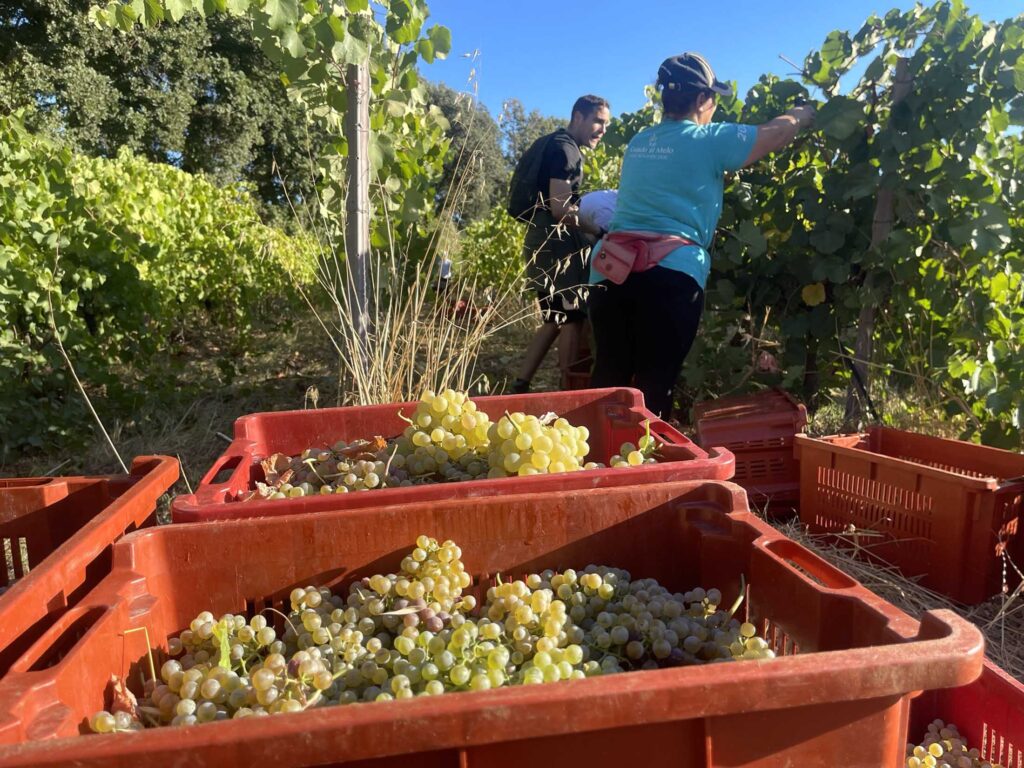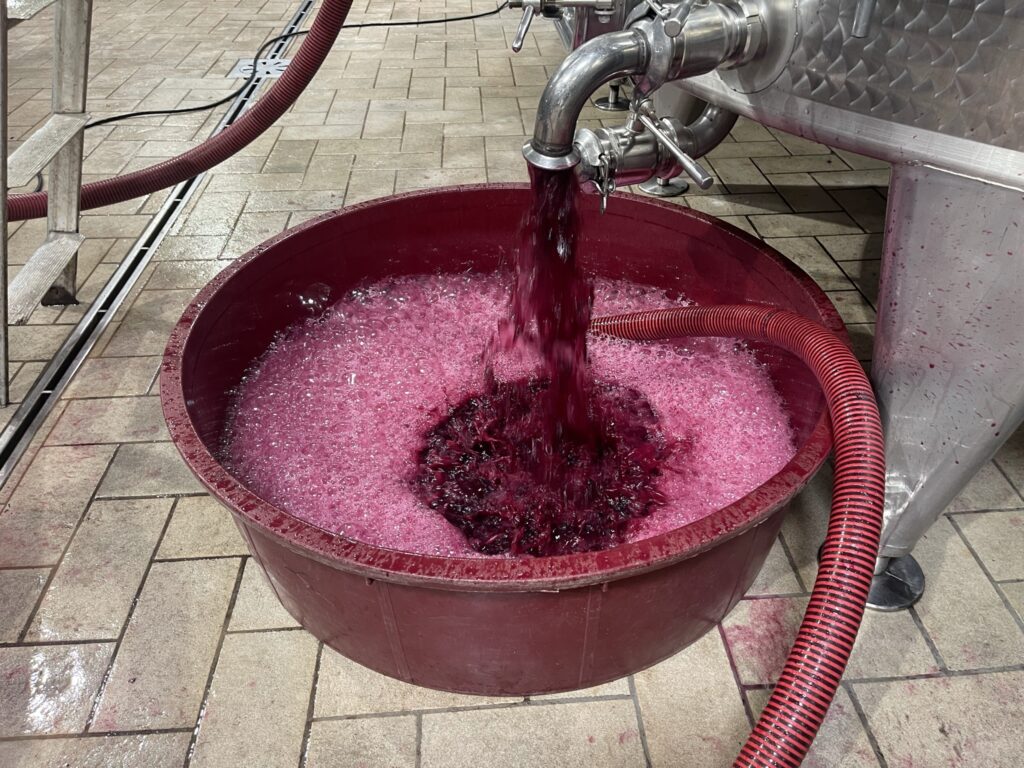Like many wineries, we too have been grappling with the latest clarifications regarding the new European wine labelling requirements. I share my notes with you, so that you can understand all the news.
However, we have discovered that we can postpone this to the wines of the 2024 vintage for our type of product. The first wines to have to put the new labelling into practice, let’s say the guinea pigs, are those whose production were be finished on the date of 08/12/2023. This only concerns refermented wines (such as sparkling wines), passito wines, etc. The majority of ‘normal’ wines have finished their production before (ageing does not count). The date is verifiable with certainty because it is fixed by the compulsory records that each wine cellar must make for every single operation on the electronic registers of the Ministry.
What will we find on the new labels?
In a nutshell, as is already the case for all foodstuffs, the obligation to indicate the ingredients, energy value and nutritional values of the product also comes into force for wine.
This is an important amount of information, which, moreover, must be offered in the language of each European country where the wine is sold. So, we have the option of just putting some data on the label and a QR code that will allow the complete information to be found online (electronic labelling).
The QR code and electronic labelling are therefore not compulsory. Those who, for example, sell a wine only in Italy, can write everything on the paper label and only in Italian. By now, these are rare cases: in reality, it becomes an obligation for the majority of wineries.
How many QR codes can you find on the label? Many, but those that fulfil legal obligations must be clearly recognisable with an inscription. In this case it is ‘ingredients’, put in all the languages of the EU countries where the wine is sold. The same QR code may also refer to environmental labelling obligations, for now only introduced in Italy. In this case, it will also have to bear the indication of it nearby.
The paper label must in any case indicate the energy value expressed in KJ and Kcal, preceded by the letter E, referring to 100 ml of wine (more or less an average glass). The data that can instead be reached on the web via the QR code include the complete nutrition table and the list of ingredients.
Don’t worry. The web-site you link to cannot track or store any user data by law. It will only be able to do the geo-localisation necessary to understand the language of the European country and propose it to the reader. Moreover, it not may contain any commercial or marketing information. When opening the website, all this data must appear immediately for the wine and in the language of the European country where you are. No further steps (no choices or windows).
It is not mandatory to make electronic labels and related QR code for different vintages of the same wine, as long as the data are identical, which is difficult for artisanal wines.
The ingredient list obviously includes the ingredients, which is only grapes for wine. There will also be additives, i.e. substances used in much smaller quantities than the actual ingredients, but which nevertheless remain in the finished product. Additives will have to be listed with the name of the functional category (e.g. stabiliser) followed by the name or just the abbreviation (e.g. lactic acid or E270).
Adjuvants are excluded from the list, i.e. those substances that may be used in the wine-making process but do not remain in the finished product. They must, however, be indicated if they are potential allergens (such as sulphites, milk or eggs derivatives). Allergens are already mandatory now. If the list of ingredients is on the electronic label, allergens must still be indicated on the paper label, as is already the case now. If the list of ingredients is on the paper label, allergens do not have to be written twice: they may only be written in the list of ingredients, highlighted (in a different font and/or by size, etc.).

Wine particularities
Wine contains no fat. The energy value only depends on the alcohol and any sugars. These data were already expressed on the label, with the alcohol content and the product category, which is indeed somewhat vague (dry wine, sweet, etc.). They are now made more readable for those accustomed to calorie counting.
The nutritional table is too much for wine. It contains no fat, very few salts, no fibre. The only interesting info is the possible presence or not of sugars. They are absent or present in traces in dry wines, while they have different doses for other categories. There are wines that are really sweet to the taste. The presence is less perceptible in others. In fact, a low residual sugar may be present in some not-sweet wines, which makes them only softer, counteracting the acidity. Sugars presence will be clearly visible from the nutritional table now.
The list of wine ingredients, on the other hand, has been awaited for years by those who think that it will finally draw a recognisable line between ‘industrial’ wines (i.e. the result of more or less extreme practices and manipulations on grapes) and those that are instead respectful of the original grapes (artisanal wines, natural wines, etc.). But is this really the case? Only partially.
Neither are the adjuvants identifiable, but neither are all the manipulations that have been achieved through processes of a physical nature, such as concentration, acidification through cation exchangers, electrodialysis for stabilisation, etc. These often have a more important effect than many additions.
This labeling system therefore says something, but not everything. Absurdly, a small winemaker risks making a “bad impression” if adds a little tartaric acid (a historical practice which adds a substance naturally present in grapes) to improve the acidity in a bad vineyard. He is obliged to report it on the label. Instead, a large industrial company will be able to improve poor quality grapes every year by using reverse osmosis concentration, without having to report it. Of course, this is an extreme example.
Everything that is not obligatory to indicate on the label will become the preferred techniques of many big wineries. Studies and surveys tell us that the shorter the list, the more consumers feel reassured about the fact that they are drinking a “genuine” product, even if we have seen some lights and shadows of this system.

What can you find on the labels
Let’s now look in detail at the categories of ingredients that you can find on the labels of European wines, i.e. those authorized in the EU. I know, sometimes this list is impressive. I assure you that it is very small compared to what they can do in the rest of the world. However, I also remember that not all these manipulations are authorized in all member states. Furthermore, some are only possible for generic wines and not for quality ones (IGT or DOC or DOCG wines).
The ingredients must be listed in descending order of weight. If they are under 2%, you can put them in your preferred order.
“Grapes”: in first place there will be the only real ingredient of the wine. This indication can be used in a generic way for wine obtained from whole grapes, pressed grapes or grape must (there are those who buy refrigerated must to make wine). The only real information that can help us understand if the company produces wine with its grapes is the wording that precedes the name of the producer, as already happens now.
Enrichment: for those who are not in the sector, this term indicates the addition of a sugary ingredient to increase the final alcohol content of the wine, more to that which would have derived naturally from the starting grapes only. If the wine is dry, you will not find these sugars in the nutritional table, because they have been fermented by yeasts. This point was one of the most fought over by the involved companies. Ultimately, EU decided that this addition must be made known to the consumer. You will therefore be able to find “concentrated grape must” written among the ingredients if concentrated grape must or concentrated and rectified grape must has been added. The second is the only enrichment allowed in Italy: the rectified must includes only the sugary part of the must, no other compounds that can modify the organoleptic characteristics. For European countries that allow sugaring or chaptalisation (not Italy, where it is prohibited), the addition of “sucrose” must be indicated, which can also be referred to generically as “sugar“. I remember that there is no sucrose in grapes, but only glucose and fructose (and other minor sugars).
Other sugary additions. In the production of refermented wines (sparkling wines) you may find the addition of “tirage liqueur“. It is the one added before the second fermentation. These sugars are fermented, so they do not remain in the finished wine (they will be not present in the nutritional table), but lead to the formation of bubbles and slightly raise the alcohol content of the first wine. Instead, if you find the wording “dosage liqueur” it means that a syrup has been added in the phase of the disgorgement (of a champagne method) or at bottling. It is a syrup added to soften or sweeten wine and remain in the final product. You find these sugars in the nutritional table. Producers can decide whether to use only these generic terms or they can also specify (in brackets) the ingredients that make up the syrups. The following ingredients can be used for the syrups, alone or mixed (some, however, are prohibited for quality sparkling wines/wines or in Italy): sucrose, grape must, concentrated grape must, rectified concentrated grape must. Partially fermented grape must, wine and wine distillate can also be used in the dosage.
Acidity regulators: some are considered additives, others adjuvants. The additives, therefore mandatory to indicate, are acidifiers such as tartaric acid (E334), malic acid (E296), lactic acid (E270), calcium sulphate (E516), citric acid (E330). The agents that reduce acidity are adjuvants and should not be indicated: potassium tartrate, potassium bicarbonate, calcium carbonate, potassium carbonate.
Preservatives and antioxidants: these must all be reported on the label. I remember sulphites, which have been mandatory for some time as they are potential allergens, such as sulfur dioxide (E220), potassium bisulphite (E228), potassium metabilsophyte (E224). Then there is potassium sorbate (E202), lysozyme (E1105), L-ascorbic acid (vitamin C, E300), dimethyldicarbonate (E242).
Clarifying agents: they are adjuvants and will not appear on the label, because in fact they do not remain in the finished wine. However, some must still appear as allergens (those derived from milk or eggs). The list is long, I’ll list just a few: edible gelatine, vegetable proteins (from potatoes, peas or other), isinglass, casein, egg albumin, bentonite, kaolin, chitosan and chitin-glucan of fungal origin, tannin, calcium or potassium alginate, yeast protein extracts, …
Stabilizing agents: Some are adjuvants, such as potassium or calcium acid tartrate, PVP PVI copolymers, potassium ferrocyanide, calcium phytate, … Others, however, should be indicated because they can remain, such as gum arabic (E414), the citric acid (E330), metatartaric acid (E353), yeast mannoproteins, carboxymethylcellulose (E466), potassium polyaspartate (E456), fumaric acid (E297).
Gases and packaging gases: gases do not appear if they are used as adjuvants, i.e. in intermediate phases and then disappear, like gaseous oxygen. Carbon dioxide (E290) can be used as an additive for wines that are made sparkling with this addition. There are gases used during the bottling phase, to preserve the wine from excessive contact with oxygen. I’m talking about argon (E938) or nitrogen (E941). In this case it is possible to choose whether to put the name (or acronym) of the gas in the list of ingredients or write “bottled in a protective atmosphere” or “bottling can take place in a protective atmosphere“.
Color corrector: it will be mandatory to indicate the use of caramel (E150), not permitted for wine but for some liqueur wines.
Then, there are particular ingredients for wines from certain production areas, such as Aleppo pine resin (for the very particular case of resinated wines), etc.
What you will never find on the label, as adjuvants:
In addition to those already indicated above, you will not find fermentation yeasts or additions of lactic bacteria. Nor will the so-called “activators of alcoholic or malolactic fermentation” be indicated, i.e. nutrients added to help yeasts and bacteria. They are consumed by these microorganisms and do not remain in the finished wine. They are microcrystalline cellulose, diammonium hydrogen phosphate, ammonium sulphate, ammonium bisulphite, thiamine hydrochloride, yeast lysates or hulls or inactive yeasts.
Enzymes: they can be used to degrade substances to be eliminated or to release aromatic precursors, therefore improving maceration, clarification, stabilization, etc. I’m talking about urease, pectin, polygalacturonase, hemicellulase,cellularase, betaglucanase, glycosidase, arabinanase, glucosidase, aspergillopepsin.
Sequestering agents: they can be used for operations aimed at removing certain substances from the wine. These are vegetal charcoal and selective vegetal fibres, which are adjuvants.
Defect corrections: copper sulphate pentahydrate, copper citrate, fungal chitosan, fungal chitin-glucan, inactivated yeasts.
If additions of fresh lees of other grapes are used during winemaking (in addition to the lees of the grapes being processed) they are adjuvants, therefore they are not included in the list of ingredients.

Winemakers’ doubts
This change was not very welcome in the world of wine, for different reasons depending on the type and size of the winery. Artisanal winemakers have not appreciated another increase in costs and obligations. They are already very heavy for Italian winemakers. Furthermore, there are several aspects that are still to be clarified and which worry them.
There is preoccupation about to do expensive analyzes every year and for each batch (in the case of wines that are not bottled all at once). The law says that you can also put average values or generally known data. Will any deviation be within the permitted tolerance or not? The risk is that we will only find out following a check by the competent authority.
In reality, except in particular cases, as mentioned, wine contains a value of 0 or traces in most substances (fibers, proteins, fats) and few salts. The most significant and variable values are alcohol and sugars (not present in a dry wine), analyzes that are already done routinely. However, clarifications are awaited on these aspects.
However, a factor that generates uncertainty is that wine is a continuously evolving product, especially for those products that can last for years or even decades. Certain values may therefore change after being placed on the market.
It is not even clear how long the electronic label must remain available on web. The directives speak of a period in which “the wine remains suitable for consumption under normal storage conditions”. Elsewhere I read “for as long as the paper label exists”. It isn’t clear! Wine is a product that does not have a certain expiry date and the bottles can continue to remain in the commercial circuits or in the cellars of restaurants or private individuals for years, even beyond the producers’ forecasts. In fact, this time can become imponderable for a winery. If no further law clarifications occur, we will have to keep the labels for a very long time to protect ourselves, with a significant accumulation of data and costs.
Furthermore, there is an implicit obligation to rely on external companies for electronic labels. Required technology is not feasible with simple “do-it-yourself” pages on the web. This increases not only costs. It also creates anxiety about entrusting this very important sensitive data to others. Even heavy sanctions depend on them, if not even the withdrawal of the bottles from the market. How long will that start-up created to take advantage of these new obligations last? How serious and safe is it? What happens to my data if it fails?

What will we do
I think that’s the obvious question you’ve been asking yourselves. Naturally, as mentioned, we can wait for the 2024 wines. I believe our wines, barring further changes in the law, will lead to this list: grapes, sulphites, bottled in a protective atmosphere.
You know how we think. Many manipulations are necessary if you start from low quality grapes only. We and other winemakers dedicate a lot of his work to taking care of the vineyard precisely to have the best possible grapes for that vintage (healthy, balanced, harvested at the perfect time). Sugar is not a problem for our Mediterranean vineyards. Our tradition also allows us to further implement balance in the wine in a “natural” way with the selection and blending between different vineyard parcels, blends between varieties or field-blends. Clarifications and stabilizations are easily done thanks to the cold of our winery and decanting. However, on our website (“how we work in the cellar”) there is a more detailed description of the various steps.
It is not so difficult for artisanal wines to have very short lists.